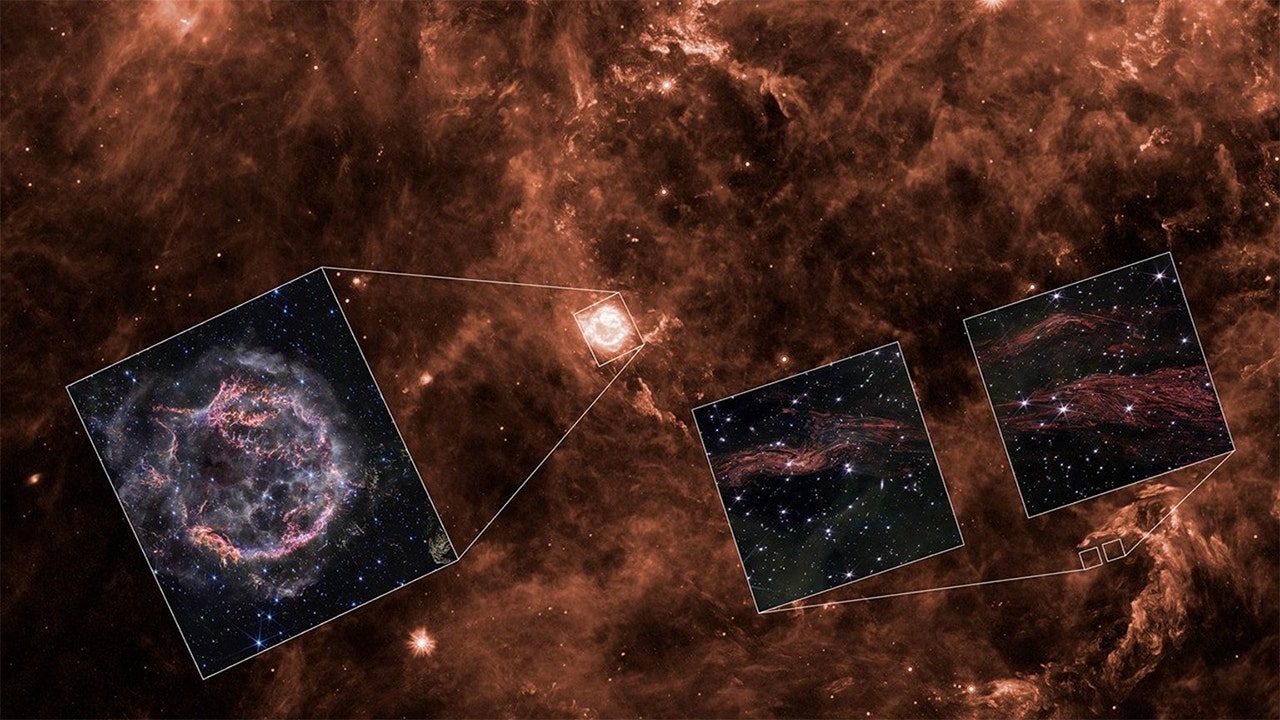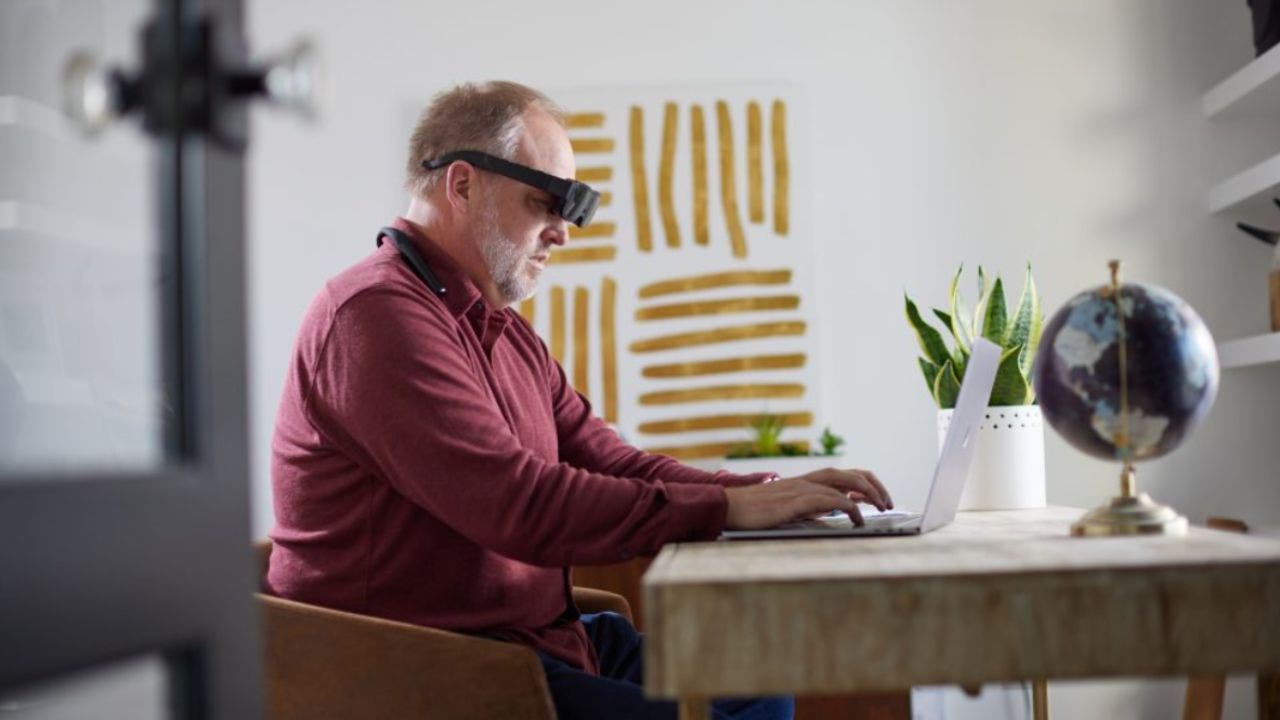Technology
Powerful Webb Telescope captures photos of one of the earliest supernova ever seen

NASA’s James Webb Space Telescope (JWST) has captured photos of one of the earliest supernovas ever seen, with features appearing like grains and knots found in a cut of wood.
“Once upon a time, the core of a massive star collapsed, creating a shockwave that blasted outward, ripping the star apart as it went,” NASA said on its website. “When the shockwave reached the star’s surface, it punched through, generating a brief, intense pulse of X-rays and ultraviolet light that traveled outward into the surrounding space.”
Now, nearly 350 years later, scientists are getting a view of the aftermath as the pulse of light reaches interstellar material and causes it to glow.
The infrared glow created was captured by JWST, revealing details that look like knots and whorls found in wood grain.
POWERFUL WEBB TELESCOPE CAPTURES MOST DISTANT KNOWN GALAXY, SCIENTISTS SAY
This background image of the region around supernova remnant Cassiopeia A was released by NASA’s Spitzer Space Telescope in 2008. By taking multiple images of this region over three years with Spitzer, researchers were able to examine a number of light echoes. Now, NASA’s James Webb Space Telescope has imaged some of these light echoes in much greater detail. Insets at lower right show one epoch of Webb observations, while the inset at left shows a Webb image of the central supernova remnant released in 2023. (Spitzer Image: NASA/JPL-Caltech/Y. Kim (Univ. of Arizona/Univ. of Chicago). Cassiopeia A Inset: NASA, ESA, CSA, STScI, Danny Milisavljevic (Purdue University), Ilse De Looze (UGent), Tea Temim (Princeton University). Light Echoes Inset: NASA, ESA, CSA, STScI, J. Jencson (Caltech/IPAC).)
“Even as a star dies, its light endures—echoing across the cosmos. It’s been an extraordinary three years since we launched NASA’s James Webb Space Telescope. Every image, every discovery, shows a portrait not only of the majesty of the universe but the power of the NASA team and the promise of international partnerships. This groundbreaking mission, NASA’s largest international space science collaboration, is a true testament to NASA’s ingenuity, teamwork, and pursuit of excellence,” NASA Administrator Bill Nelson said. “What a privilege it has been to oversee this monumental effort, shaped by the tireless dedication of thousands of scientists and engineers around the globe. This latest image beautifully captures the lasting legacy of Webb—a keyhole into the past and a mission that will inspire generations to come.”
While beautiful in nature, the observations also give astronomers the ability to map the 3-dimensional structure of the interstellar dust and gas for the first time.
“We were pretty shocked to see this level of detail,” Jacob Jencson of Caltech/IPAC in Pasadena, the principal investigator of the science program, said.
Josh Peek of the Space Telescope Science Institute in Baltimore is also a member of the team and said they see layers like those of an onion.
POWERFUL WEBB TELESCOPE SPIES SPECTACULAR STAR BIRTH CLUSTER BEYOND THE MILKY WAY

These shimmering cosmic curtains show interstellar gas and dust that has been heated by the flashbulb explosion of a long-ago supernova. (NASA, ESA, CSA, STScI, J. Jencson (Caltech/IPAC))
“We think every dense, dusty region that we see, and most of the ones we don’t see, look like this on the inside,” he said. “We just have never been able to look inside them before.”
The images produced from the JWST near-infrared camera (NIRCam) highlight a phenomenon called light echo, NASA said, which is created when a star explodes or erupts before flashing light into surrounding masses of dust and causing them to shine.
The visible light echoes are caused when the light reflects off interstellar material, where those at infrared wavelengths are caused when the dust is warmed by energetic radiation, causing it to glow.
Scientists targeted a light echo previously observed by NASA’s retired Spitzer Space Telescope, and it is one of dozens found near remains of the Cassiopeia A supernova.
MERGER OF MASSIVE BLACK HOLES FROM EARLY UNIVERSE UNCOVERED BY WEBB TELESCOPE, SCIENTISTS SAY

FILE – In this April 13, 2017 photo provided by NASA, technicians lift the mirror of the James Webb Space Telescope using a crane at the Goddard Space Flight Center in Greenbelt, Md. (Laura Betz/NASA via AP, File)
The Webb images show tightly packed sheets, with filaments displaying structures on what NASA called “remarkably small scales,” of about 400 astronomical units, or less than one-hundredth of a light year. One astronomical unit is the average distance between the Earth and the Sun, and Neptune’s orbit is 60 astronomical units in diameter.
“We did not know that the interstellar medium had structures on that small of a scale, let alone that it was sheet-like,” Peek said.
The discovery was compared by scientists to a medical CT scan.
“We have three slices taken at three different times, which will allow us to study the true 3D structure. It will completely change the way we study the interstellar medium,” Armin Rest of the Space Telescope Science Institute, and member of the team, said.
The team’s findings will be presented this week at the 245th American Astronomical Society meeting in Washington, D.C.
The Webb Telescope, the successor to the Hubble and the largest telescope ever launched into space, is a joint project of NASA and the European Space Agency.

Technology
LG Display announces its brightest, most striking OLED TV panel yet
/cdn.vox-cdn.com/uploads/chorus_asset/file/25833258/Screenshot_2025_01_15_at_8.11.01_PM.png)
The new panel’s innovation centers on a Primary RGB Tandem structure, which is LG Display’s proprietary technology that uses independent stacks of RGB elements to produce light. It had previously used a three-stack light source, with two layers of blue elements emitting relatively short energy wavelengths alongside red, green, and yellow elements in a single layer.
The Primary RGB Tandem structure applied to the fourth-generation OLED TV panel organizes the light source into four stacks by adding two layers of blue elements and independent layers of red and green elements. It improves maximum brightness by increasing the amount of light produced by each layer compared to the previous structure.
Technology
Super Bowl LIX will stream for free on Tubi
/cdn.vox-cdn.com/uploads/chorus_asset/file/25832751/2192581677.jpg)
Fox announced on Wednesday that Super Bowl LIX will stream live on Tubi, its free, ad-supported streaming service, when it kicks off on February 9th, 2025. You’ll be able to stream the game in 4K for free from the service’s app on your phone or smart TV, without creating or logging into an account.
This is the first time the Super Bowl will be available on Tubi. It’s also its biggest live sporting event yet. The free streaming platform, which Fox acquired in 2020, reported reaching 97 million monthly active users earlier this month.
Though Fox had the broadcast rights to the Super Bowl LVII in 2023, it only aired the game on its linear TV channel, website, and app, while giving cord-cutters the option to access the game on pricey live TV streaming services like Fubo and Sling TV. Perhaps the Tubi “interface interruption” commercial shown during Super Bowl LVII was a hint of what’s to come.
Tubi’s Super Bowl coverage will begin at 3:30PM ET on February 9th with a red-carpet event hosted by Olivia Culpo. Along with Tubi, Super Bowl LIX will air across Fox, Fox Deportes, Telemundo, Fox’s website, and the NFL Plus app.
Technology
Fox News AI Newsletter: AI health tech will transform your fitness routine

Welcome to Fox News’ Artificial Intelligence newsletter with the latest AI technology advancements.
IN TODAY’S NEWSLETTER:
– Best cutting-edge health and fitness tech from CES 2025
– Nvidia pushes back on Biden admin’s ‘misguided’ AI order
– Biden White House announces ‘final rule’ on AI chip exports before Trump hand-off, drawing industry blowback
FUTURE HEALTH TECH: CES 2025 has once again showcased a remarkable array of health and fitness technology that promises to transform our well-being.
‘UNPRECEDENTED AND MISGUIDED’: Tech giant Nvidia is pushing back on a new executive order by the Biden administration that seeks to prevent artificial intelligence technologies developed in the U.S. from falling into the hands of adversarial countries.
‘CHIP’ ON THEIR SHOULDER: The Biden White House on Monday announced its “final rule” placing export controls on artificial intelligence chips before President-elect Donald Trump takes office next week, drawing swift condemnation from industry leaders who argue the Democratic administration is effectively undermining America’s leadership in the emerging technology.

FILE – Amazon Web Services data center is seen on Thursday, Aug. 22, 2024, in Boardman, Ore. (AP Photo/Jenny Kane, File)
‘LEAD THE WORLD’: President Biden on Tuesday signed an ambitious executive order that he says will keep both national security and climate change in mind while fast-tracking the build-out of large-scale artificial intelligence infrastructure in the United States.
HOTTEST TICKET IN TOWN: A select group of tech industry titans and venture capitalists will gather in Washington, D.C., this week to welcome the incoming Trump administration and celebrate new opportunities for global innovation in artificial intelligence and entrepreneurship.
CUTTING-EDGE HUMANOID TECH: Chinese startup Pudu Robotics has unveiled its latest creation, the D9 humanoid robot, designed to revolutionize the way we work and interact with machines.

D9 humanoid robot (Pudu Robotics)
Subscribe now to get the Fox News Artificial Intelligence Newsletter in your inbox.
FOLLOW FOX NEWS ON SOCIAL MEDIA
Facebook
Instagram
YouTube
Twitter
LinkedIn
SIGN UP FOR OUR OTHER NEWSLETTERS
Fox News First
Fox News Opinion
Fox News Lifestyle
Fox News Health
DOWNLOAD OUR APPS
Fox News
Fox Business
Fox Weather
Fox Sports
Tubi
WATCH FOX NEWS ONLINE
Fox News Go
STREAM FOX NATION
Fox Nation
Stay up to date on the latest AI technology advancements and learn about the challenges and opportunities AI presents now and for the future with Fox News here.
-
/cdn.vox-cdn.com/uploads/chorus_asset/file/25822586/STK169_ZUCKERBERG_MAGA_STKS491_CVIRGINIA_A.jpg)
/cdn.vox-cdn.com/uploads/chorus_asset/file/25822586/STK169_ZUCKERBERG_MAGA_STKS491_CVIRGINIA_A.jpg) Technology7 days ago
Technology7 days agoMeta is highlighting a splintering global approach to online speech
-

 Science4 days ago
Science4 days agoMetro will offer free rides in L.A. through Sunday due to fires
-
/cdn.vox-cdn.com/uploads/chorus_asset/file/25821992/videoframe_720397.png)
/cdn.vox-cdn.com/uploads/chorus_asset/file/25821992/videoframe_720397.png) Technology1 week ago
Technology1 week agoLas Vegas police release ChatGPT logs from the suspect in the Cybertruck explosion
-

 Movie Reviews1 week ago
Movie Reviews1 week ago‘How to Make Millions Before Grandma Dies’ Review: Thai Oscar Entry Is a Disarmingly Sentimental Tear-Jerker
-

 Health1 week ago
Health1 week agoMichael J. Fox honored with Presidential Medal of Freedom for Parkinson’s research efforts
-

 Movie Reviews1 week ago
Movie Reviews1 week agoMovie Review: Millennials try to buy-in or opt-out of the “American Meltdown”
-

 News1 week ago
News1 week agoPhotos: Pacific Palisades Wildfire Engulfs Homes in an L.A. Neighborhood
-

 World1 week ago
World1 week agoTrial Starts for Nicolas Sarkozy in Libya Election Case













